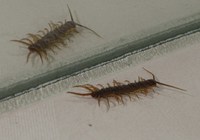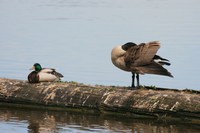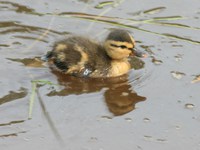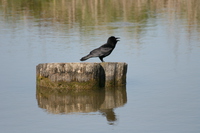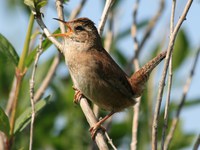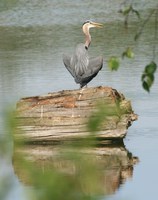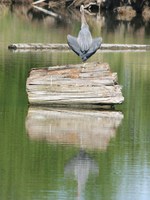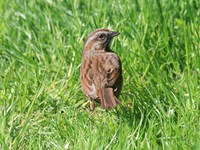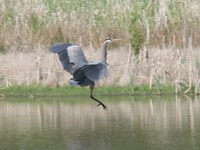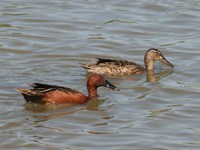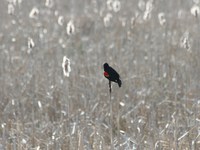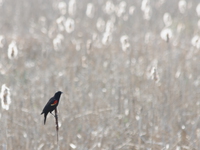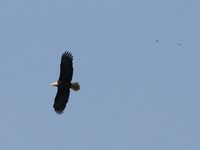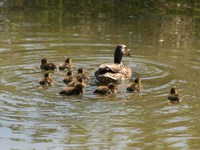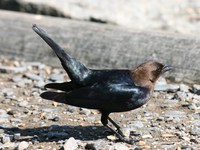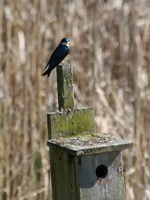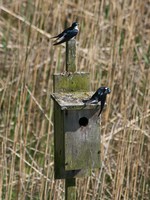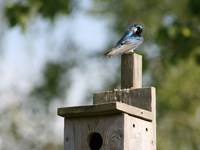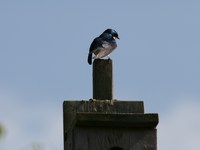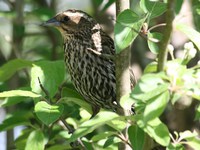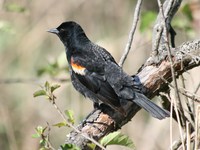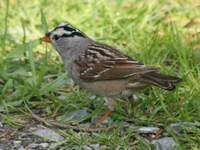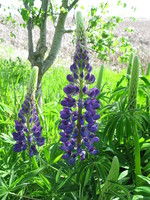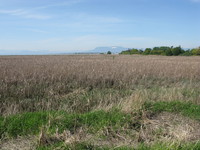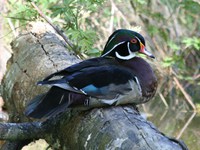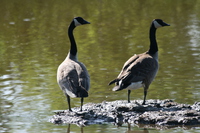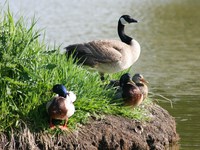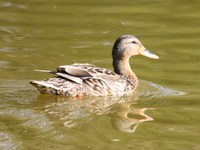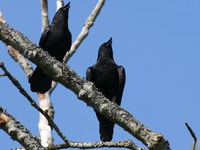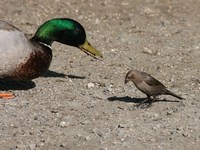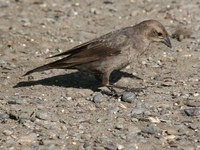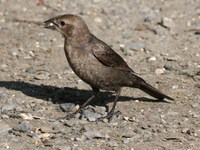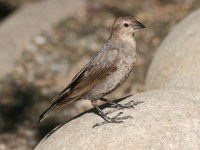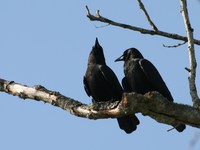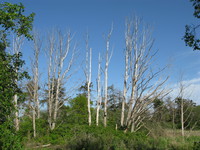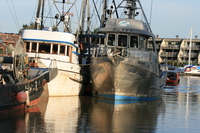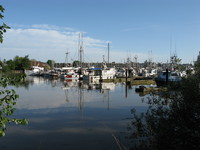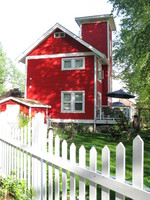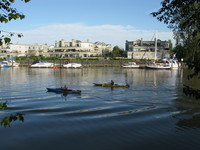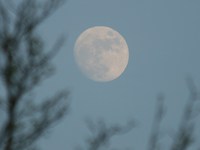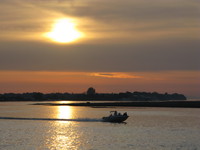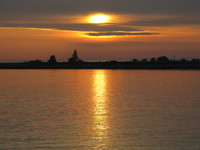reifel bird sanctuary
The Common Raven (Corvus corax), also known as the Northern Raven, is a large all-black passerine bird in the crow family. Found across the northern hemisphere, it is the most widely distributed of all corvids. There are eight known subspecies with little variation in appearance, although recent research has demonstrated significant genetic differences among populations from various regions. It is one of the two largest corvids, alongside the Thick-billed Raven, and is possibly the heaviest passerine bird; at maturity, the Common Raven is between 56 and 69 cm (22 to 27 inches) in length, with recorded weights ranging from 0.69 to 1.63 kg (1.5 to 3.6 pounds). Common Ravens typically live about 10 to 15 years in the wild, although lifespans of up to 40 years have been recorded. Young birds may travel in flocks, but later mate for life, with each mated pair defending a territory.
The Common Raven has coexisted with humans for thousands of years, and in some areas has been so successful that it is considered a pest. Part of its success comes from its omnivorous diet; Common Ravens are extremely versatile and opportunistic in finding sources of nutrition, feeding on carrion, insects and food waste, in addition to cereal grains, berries, fruit and small animals.
Some remarkable feats of problem-solving have been observed in the species, leading to the belief that it is highly intelligent. Over the centuries, it has been the subject of mythology, folklore, art and literature. In many indigenous cultures, including those of Scandinavia, ancient Ireland and Wales, Bhutan, the northwest coast of North America, Siberia and northeast Asia, the Common Raven has been revered as a spiritual figure or god.
The Bewick's Wren (Thryomanes bewickii) is a wren native to North America. At about 4cm long, it is gray-brown above, white below, with a long white eyebrow. While similar in appearance to the Carolina Wren, it has a long tail that is tipped in white. The song is loud and melodious, much like the song of other wrens. It lives in thickets, brush piles and hedgerows, open woodlands and scrubby areas, often near streams. Its range is from southern British Columbia, Nebraska, southern Ontario, and southwestern Pennsylvania south to Mexico, Arkansas and the northern Gulf States. It usually lays 5-7 eggs that are white with brown spots.
This is currently the only species of its genus, Thryomanes. The Socorro Wren, formerly placed here too, is actually a close relative of the House Wren complex, as indicated by biogeography and mtDNA NADH dehydrogenase subunit 2 sequence analysis, whereas Thryomanes seems not too distant from the Carolina Wren.
The Great Blue Heron , Ardea herodias, is a wading bird in the heron family Ardeidae, common over most of North and Central America as well as the West Indies and the Gal�pagos Islands, except for the far north and deserts and high mountains where there is no water for it to feed in. It is an extremely rare vagrant to Europe, with records from Spain, the Azores and England.
It is the largest North American heron, with a head-to-tail length of 91�137 cm (36-54 in), a wingspan of 180 cm (71 in), and a weight of 2.2�3.6 kg (4.8-8 lbs). It is blue-gray overall, with black flight feathers, red-brown thighs, and a paired red-brown and black stripe up the flanks; the neck is rusty-gray, with black and white streaking down the front; the head is paler, with a nearly white face, and a pair of black plumes running from just above the eye to the back of the head. The feathers on the lower neck are long and plume-like; it also has plumes on the lower back at the start of the breeding season. The bill is dull yellowish, becoming orange briefly at the start of the breeding season, and the lower legs gray, also becoming orangey at the start of the breeding season. Immature birds are duller in color, with a dull blackish-gray crown, and the flank pattern only weakly defined; they have no plumes, and the bill is dull gray-yellow.
The Savannah Sparrow (Passerculus sandwichensis) is a small American sparrow. It is the only widely accepted member of the genus Passerculus. Recent comparison of mtDNA NADH dehydrogenase subunit 2 and 3 sequences indicates that the Ipswich Sparrow, formerly usually considered a good species (as Passerculus princeps), is a well-marked subspecies of the Savannah Sparrow, whereas the southwestern subspecies should be recognized as distinct species Large-billed Sparrow (Passerculus rostratus).
It is named after Savannah, Georgia where one of the first specimens of this bird was collected.
This passerine bird breeds in Alaska, Canada, northern, central and Pacific coastal USA, Mexico and Guatemala. The Pacific and Mexican breeders are resident, but other populations are migratory, wintering from the southern United States to northern South America. It is a very rare vagrant to western Europe.
The Great Blue Heron is found throughout most of North America, including Alaska, British Columbia, Quebec, New Brunswick and Nova Scotia. The range extends south through Florida, Mexico and the Caribbean to South America. Great Blue Herons can be found in a range of habitats, in fresh and saltwater marshes, mangrove swamps, flooded meadows, lake edges, or shorelines, but they always live near bodies of water. Generally, they nest in trees or bushes near a body of water.
The Cinnamon Teal, Anas cyanoptera, is a small dabbling duck from the Americas.
The adult male has a cinnamon-red head and body with a brown back, a red eye and a dark bill. The adult female has a mottled brown body, a pale brown head, brown eyes and a grey bill and is very similar in appearance to a female Blue-winged Teal.
Their breeding habitat is marshes and ponds in western North and South America. Cinnamon Teal generally select new mates each year. They are migratory and most winter in northern South America and the Caribbean, generally not migrating as far as the Blue-winged Teal. These birds feed by dabbling. They mainly eat plants; their diet may include molluscs and aquatic insects.
The Bald Eagle (Haliaeetus leucocephalus) is a bird of prey found in North America that is most recognizable as the national bird and symbol of the United States of America. This sea eagle has two known sub-species and forms a species pair with the White-tailed Eagle. Its range includes most of Canada and Alaska, all of the contiguous United States and northern Mexico. It is found near large bodies of open water with an abundant food supply and old-growth trees for nesting.
The Bald Eagle is a large bird, with a body length of 71�96 centimeters (28�38 in), a wingspan of 168�244 centimeters (66�88 in), and a mass of 3�6.3 kilograms (6.6�14 lb); females are about 25 percent larger than males. The adult Bald Eagle has a brown body with a white head and tail, and bright yellow irises, taloned feet, and a hooked beak; juveniles are completely brown except for the yellow feet. Males and females are identical in plumage coloration. Its diet consists mainly of fish, but it is an opportunistic feeder. It hunts fish by swooping down and snatching the fish out of the water with its talons. It is sexually mature at four years or five years of age. The Bald Eagle builds the largest nest of any North American bird, up to 4 meters (13 ft) deep, 2.5 meters (8 ft) wide, and one tonne (1.1 tons) in weight.
The species was on the brink of extirpation in the continental United States (while flourishing in much of Alaska and Canada) late in the 20th century, but now has a stable population and has been officially removed from the U.S. federal government's list of endangered species. The Bald Eagle was officially reclassified from "Endangered" to "Threatened" on July 12, 1995 by the United States Fish and Wildlife Service. On July 6, 1999, a proposal was initiated "To Remove the Bald Eagle in the Lower 48 States From the List of Endangered and Threatened Wildlife." It was delisted on June 28, 2007.
The mallard is 56�65 cm long, has a wingspan of 81�98 cm, and weighs seven to eight pounds. The breeding male is unmistakable, with a green head, black rear end and a yellow bill tipped with black (as opposed to the dark brown bill in females). The female Mallard is light brown, like most female dabbling ducks. However, both the female and male Mallards have distinct purple speculum edged with white, prominent in flight or at rest (though temporarily shedded during the annual summer molt). In non-breeding (eclipse) plumage the drake becomes drab, looking more like the female, but still distinguishable by its yellow bill and reddish breast.
The Mallard is a rare example of both Allen's Rule and Bergmann's Rule in birds. Bergmann's Rule, which states that polar forms tend to be larger than related ones from warmer climates, has numerous examples in birds. Allen's Rule says that appendages like ears tend to be smaller in polar forms to minimize heat loss, and larger in tropical and desert equivalents to facilitate heat diffusion, and that the polar taxa are stockier overall. Examples of this rule in birds are rare, as they lack external ears. However, the bill of ducks is very well supplied with blood vessels and is vulnerable to cold.
The size of the Mallard varies clinally, and birds from Greenland, although larger than birds further south, have smaller bills and are stockier. It is sometimes separated as subspecies Greenland Mallard (A. p. conboschas).
In captivity, domestic ducks come in wild-type plumages, white, and other colours. Most of these colour variants are also known in domestic mallards not bred as livestock, but kept as pets, aviary birds, etc., where they are rare but increasing in availability.
A noisy species, the male has a nasal call, the female the "quack" always associated with ducks.
The Brown-headed Cowbird (Molothrus ater) is a small brood parasitic icterid of temperate to subtropical North America. They are permanent residents in the southern parts of their range; northern birds migrate to the southern United States and Mexico in winter, returning to their summer habitat about March/April.
They resemble New World orioles in general shape but have a finch-like head and beak. Adults have a short finch-like bill and dark eyes. The adult male is mainly iridescent black with a brown head. The adult female is grey with a pale throat and fine streaking on the underparts.
The Tree Swallow, Tachycineta bicolor, is a migratory passerine bird that breeds in North America and winters in Mexico, Central America and the Caribbean. It is a very rare vagrant to western Europe.
This swallow averages 13.5 cm (5 inches) long and weighs about 20g. The bill is tiny. The adult Tree Swallow has iridescent blue-green upperparts, white underparts, and a very slightly forked tail. The female usually has duller colours than the male, often more greenish than the more bluish male. The juvenile plumage is dull grey-brown above and may have hint of a gray breast band.
The Savannah Sparrow has a typically sparrow-like dark-streaked brown back, and whitish underparts with brown or blackish breast and flank streaking. It has a yellowish or whitish crown and eyebrow stripes. The cheeks are brown and the throat white.
The Savannah Sparrow is a very variable species, with numerous subspecies, several of which have been split as separate species at various times. The different forms vary principally in the darkness of the plumage, with Alaskan and interior races the palest, and southwestern coastal forms the darkest; by and large ths agrees with the new species limits. The Savannah Sparrows proper (see below) are very similar and migrant birds can not usually be related to a breeding population with certainty. The resident or partially migratory subspecies are well distinguishable by size and, particularly between groups, coloration. The song is mixture of chirps and trills. The flight call is a thin seep.
The Red-winged Blackbird (Agelaius phoeniceus) is a passerine bird of the family Icteridae found in most of North and much of Central America. It breeds from Alaska and Newfoundland south to Florida, the Gulf of Mexico, Mexico and Guatemala, with isolated populations in western El Salvador, northwestern Honduras and northwestern Costa Rica. It may winter as far north as Pennsylvania and British Columbia, but northern populations are generally migratory, moving south to Mexico and the southern United States.
The common name for this species is taken from the mainly black adult male's distinctive red shoulder patches, or "epaulets", which are visible when the bird is flying or displaying. At rest, the male also shows a pale yellow wingbar.
The female is blackish-brown and paler below. The female is considerably smaller than the male, at 17-18 cm (7 inches) length and 36 g weight, against his 22-24 cm (9.5 inches) and 64 g.
Young birds resemble the female, but are paler below and have buff feather fringes. Both sexes have a sharply pointed bill.
The White-crowned Sparrow (Zonotrichia leucophrys) is a medium-sized sparrow native to North America. Adults are 18 cm (7 in) long and have black and white stripes on their head, a grey face, brown streaked upper parts and a long tail. The wings are brown with bars and the underparts are grey. Their bill is pink or yellow. They are similar in appearance to the White-throated Sparrow but do not have the white throat markings.
The Wood Duck or Carolina Duck, Aix sponsa is a medium-sized perching duck. A typical adult is about 19 inches in length with an average wingspan of 29 inches. This is about three-quarters of the length of an adult Mallard. It shares its genus with the Asian Mandarin Duck.
The adult male has distinctive multi-colored iridescent plumage and red eyes. The female, less colorful, has a white eye-ring and a whitish throat. Both adults have crested heads. When swimming, wood ducks bob their head back and forth in a jerking motion, which makes them easy to spot.
Their breeding habitat is wooded swamps, shallow lakes, marshes or ponds in eastern North America, the west coast of the United States and western Mexico. They usually nest in cavities in trees close to water, although they will take advantage of nesting boxes in wetland locations if available. Their personality is shy and skittish.
Females typically lay between 9 and 14 eggs. However, if nesting boxes are placed too close together, females may lay eggs in the nests of their neighbors, which may lead to nests which may contain as many as 40 eggs and unsuccessful incubation, a behavior known as "nest dumping". They prefer nesting over water so the young have a soft landing, but will nest up to 150 yards (140 m) away from the shoreline. The day after they hatch, the young climb to the nest entrance and jump to the ground. The baby ducks can swim and find their own food by this time.
The Northwestern Crow (Corvus caurinus) is an all-black passerine bird of the crow genus native to the northwest of North America. It is very similar to the more western forms of the widespread American Crow (Corvus brachyrhynchos) but it is slightly smaller (33-41 cm in length) and has proportionately smaller feet with a slightly more slender bill. It is the calls that are significantly different and often serve to identify it.
Mallards form pairs only until the female lays eggs, at which time she is left by the male. The clutch is 8�13 eggs, which are incubated for 27�28 days to hatching with 50�60 days to fledging. The ducklings are precocial, and can swim and feed themselves on insects as soon as they hatch, although they stay near the female for protection. Young ducklings are not naturally waterproof and rely on the mother to provide waterproofing. Mallards also have rates of male-male sexual activity that are unusually high for birds. In some cases, as many as 19% of pairs in a Mallard population are male-male homosexual.
When they pair off with mating partners, often one or several drakes will end up "left out". This group will sometimes target an isolated female duck � chasing, pestering and pecking at her until she weakens (a phenomenon referred to by researchers as rape flight), at which point each male will take turns copulating with the female. Male Mallards will also occasionally chase other males in the same way. (In one documented case, a male Mallard copulated with another male he was chasing after it had been killed when it flew into a glass window.)
Very similar to that of the Fish Crow; the Northwestern Crow eats stranded fish, shellfish, crabs and mussels, and also searches through refuse containers for suitable food items. It has been seen to fly into the air with mussels and drop them onto hard surfaces to break them open. It also regularly eats insects, other invertebrates, and various fruits (especially berries). It raids other birds' nests to eat eggs and hatchlings. It takes handouts and remembers anyone who discards food. It is known to soak pieces of bread in water.
Direction to George Reifel Migratory Bird Sanctuary
Fly to Canada, British Columbia, Vancouver
From Richmond (you would need a car, I don't think there is public transport)
Drive south from Highway 99
exit River Road, near Ladner
drive South
turn left at Ferry Rd, then right at Westminister Ave.,
continue on to Bridge street, then Garry Street,
turn right at 47th Avenue, then continue to River Road again,
all the way, the Westham Island Rd is at your right hand side (it is very easy to miss),
drive all the way through Westham Island Rd and you will see the Reifld Bird Sanctuary.
Opening time for George Reifel Migratory Bird Sanctuary
From 9:00am to 4:00pm, no entry after 4:00pm, but you can leave after 5:30pm. I left at 5:50pm and they still haven't locked the gates yet. I guess they lock it at around 7:00pm? I won't recommend leaving after 6:00pm.
Entrance is $4.00 for adult as of May 2008, the $0.5 for bird feed is recommended.
Best season is Mid March to Mid April and Mid October to Mid December for the snow geese migration.

